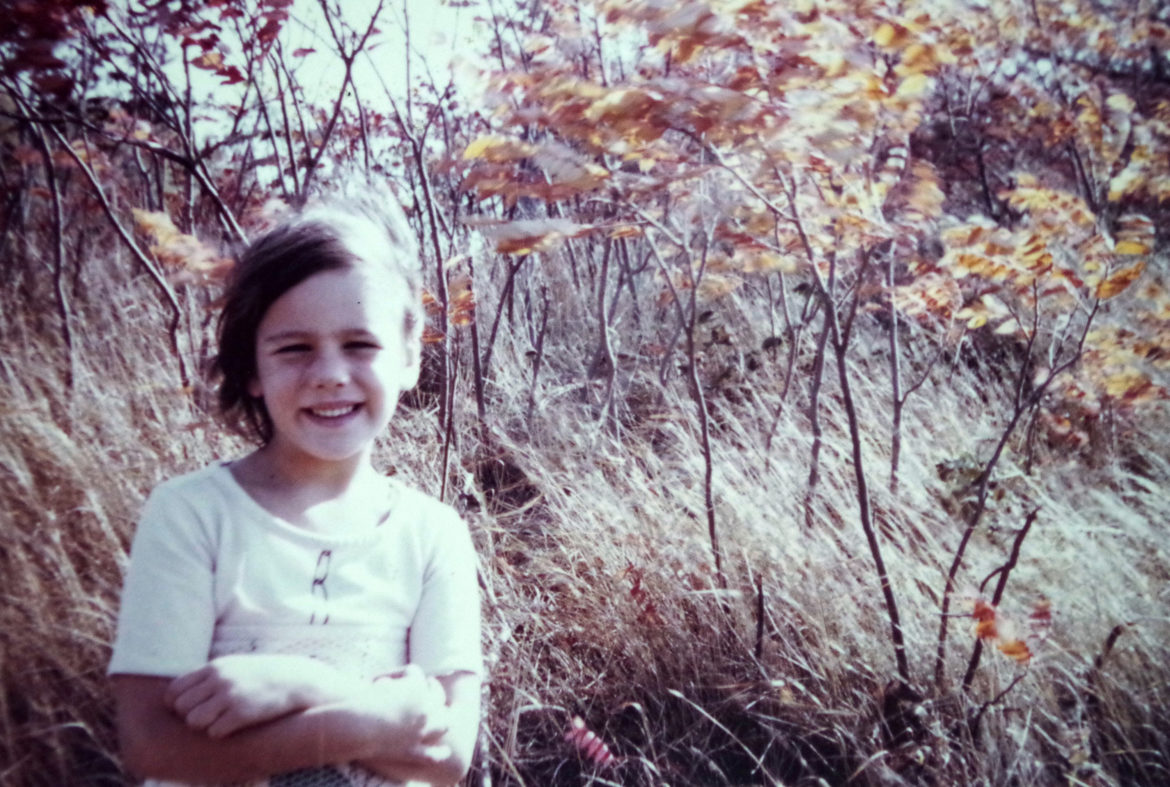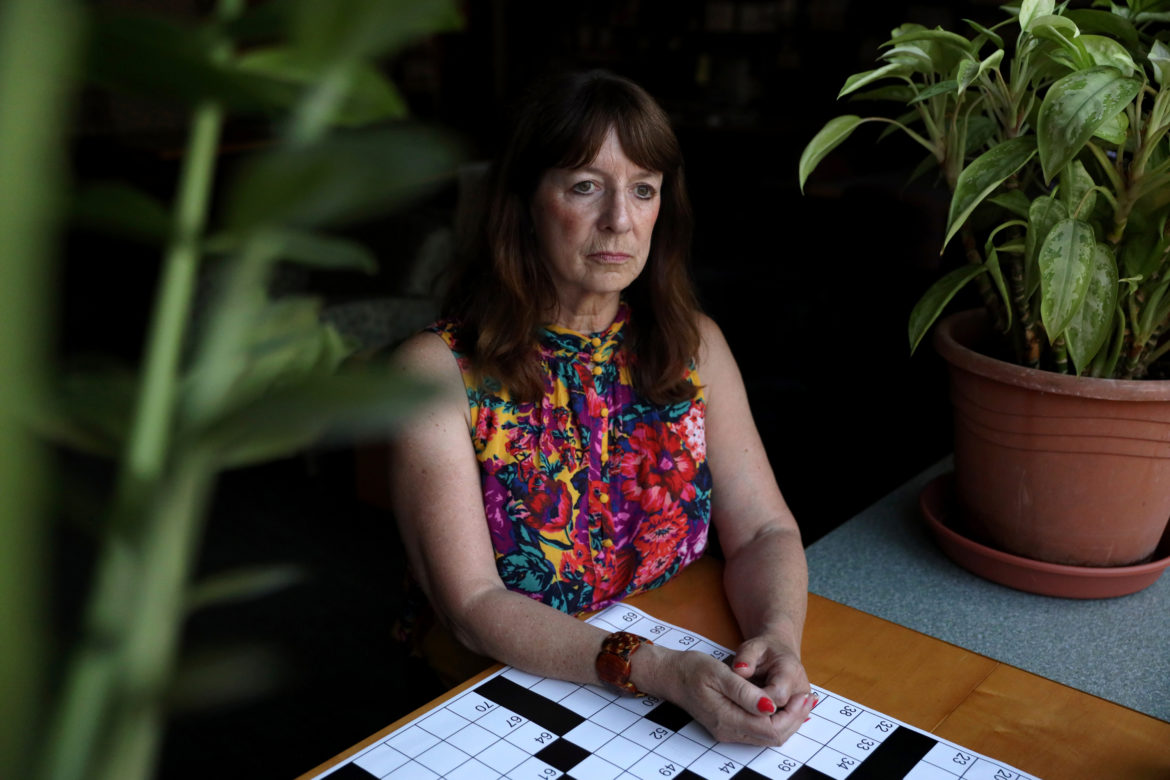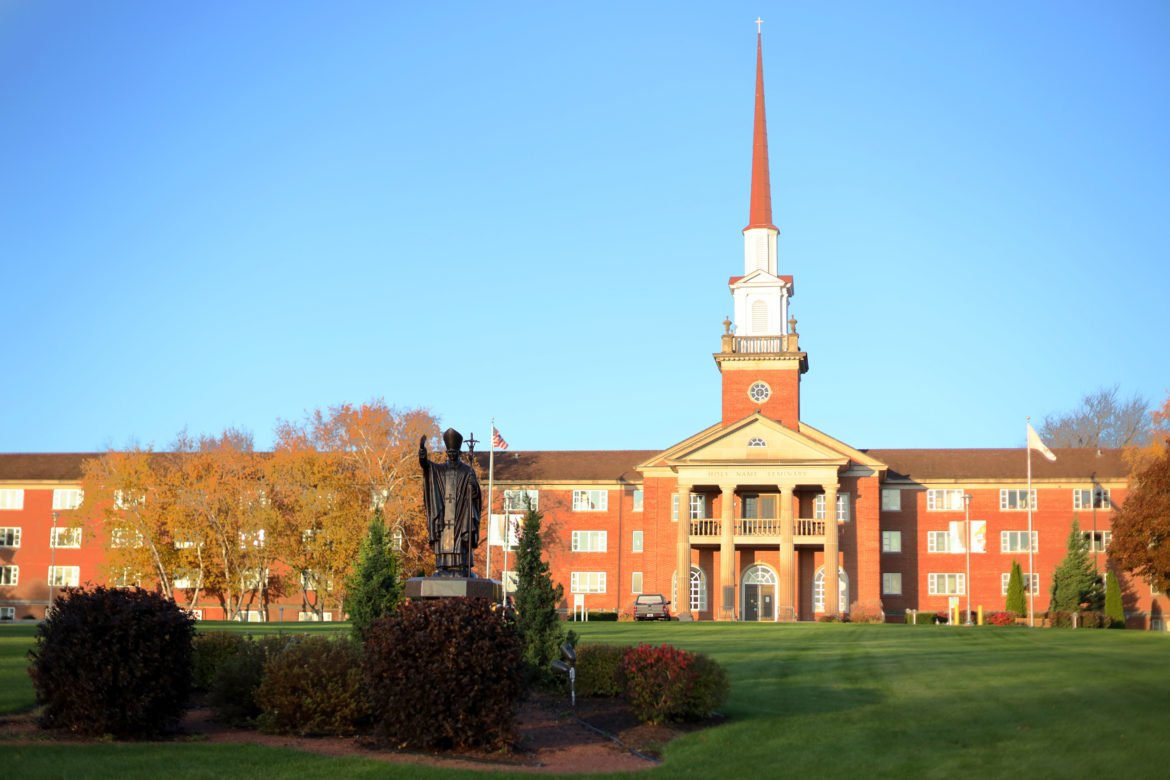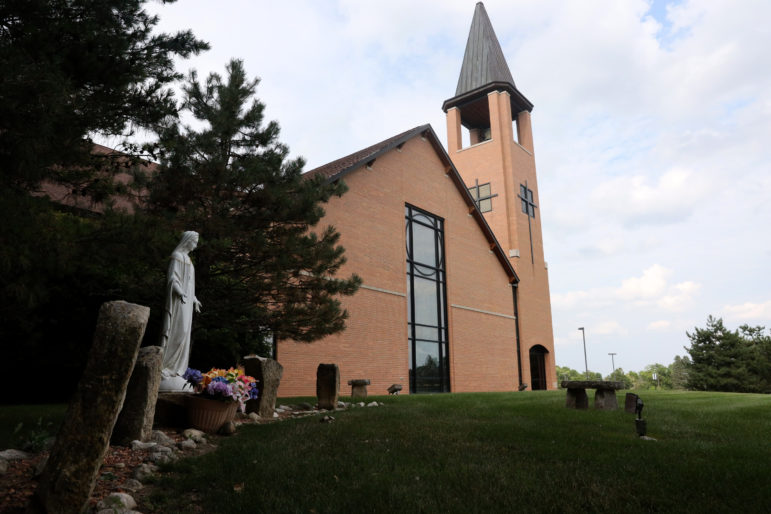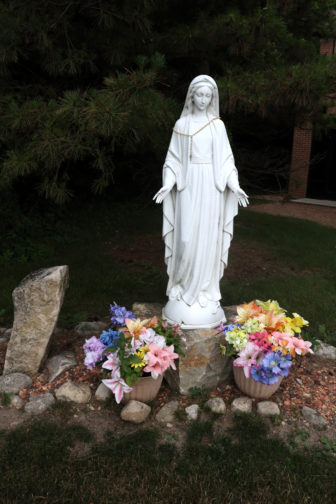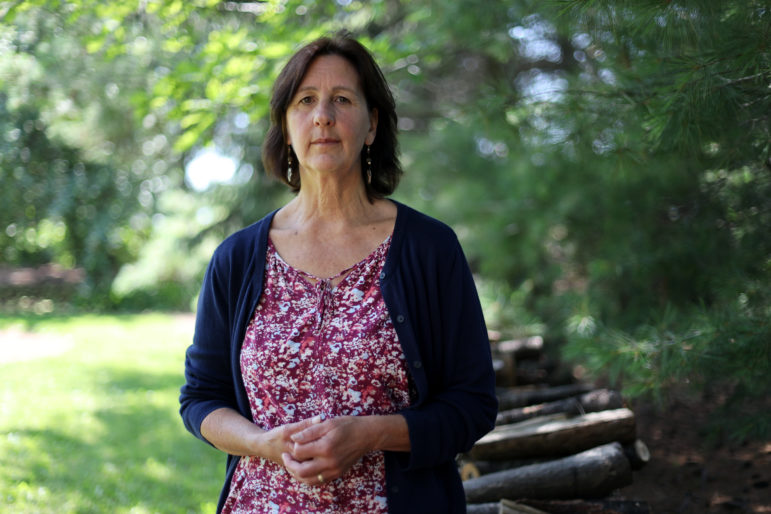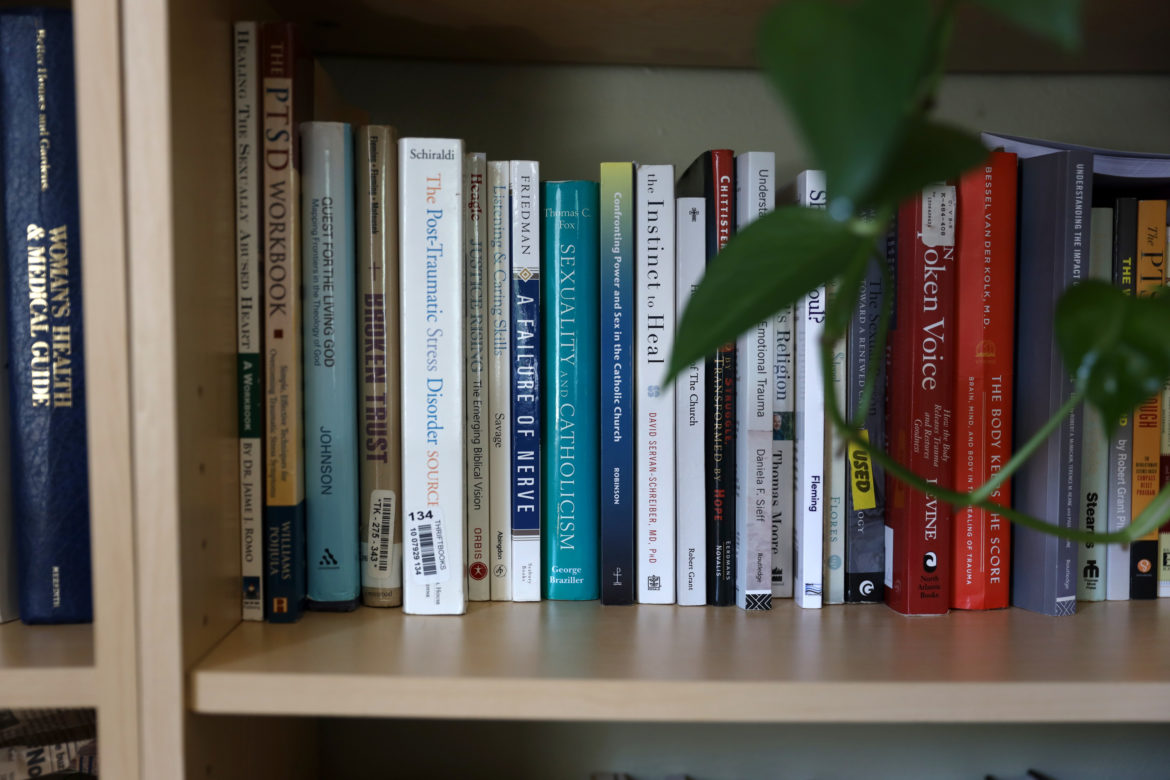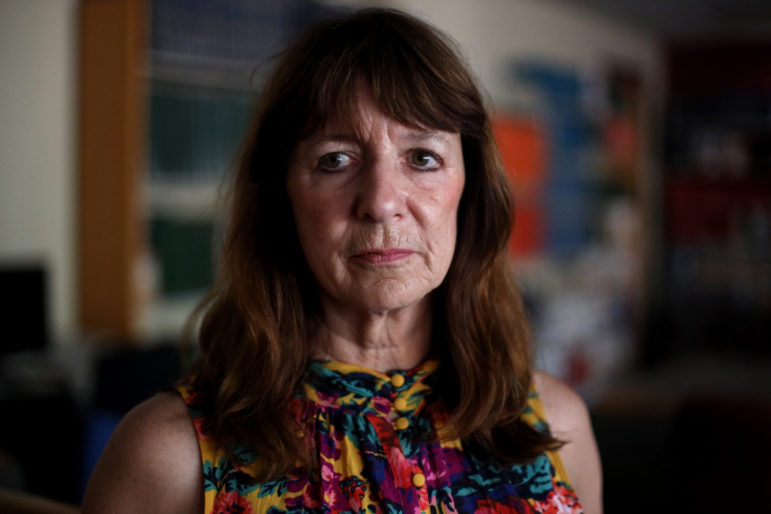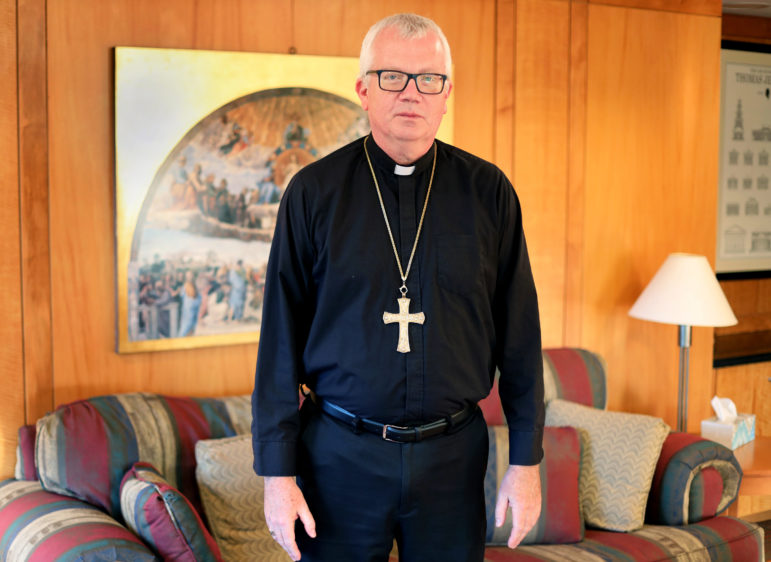‘i Was Such a Little Kid’: As Wisconsin Catholic Clergy Accused of Sexual Abuse Grows, the Trauma Lingers
By Erica Jones
When she was 7, Patty Gallagher was chosen to bring the priest who served her parish and school in Monona, Wisconsin, his daily milk. The Rev. Lawrence Trainor was practically a member of the family. He came over for dinner and visited the family cottage. Gallagher’s father and Trainor played cards and drank together. Trainor, a priest at Immaculate Heart of Mary Church, ingratiated himself with her parents. And then, Gallagher said, he “raped me in every way possible.” “I had to make my first confession with this man and say the words, ‘Bless me, Father, for I have sinned,’ to the man who raped me in the most horrific ways,” said Gallagher, of Milwaukee, whose last name is now Gallagher Marchant. “There are no words to describe that.” Gallagher Marchant, a psychotherapist, said she repressed these traumatic memories for decades. She was aware that she had been hurt, but she could not remember by whom.
When Gallagher Marchant was 35 and her daughter turned 7 — the same age she was in 1965 at the time of her own abuse — the memories came flooding back. She knew she had to tell someone, so she reached out to the Catholic Diocese of Madison. The year was 1991. In the end, Gallagher Marchant received a “six-figure” settlement in 1992 for alleged abuse suffered at the hands of Trainor. Since then, Gallagher Marchant said, “I’ve been speaking for 30 years, because I can’t not talk about what’s so blatantly wrong.” Many U.S. institutions have been rocked by sexual abuse scandals in recent years, including the Southern Baptist Convention, the Boy Scouts of America, USA Gymnastics and, more recently, Calvary Gospel Church in Madison, Wisconsin. But it is the scandal within the Catholic Church that continues to garner the most attention, prompting Pope Francis in May to issue the first worldwide mandate that all child sex abuse allegations be reported to church authorities — a measure that critics say still falls short. “Abuse can happen everywhere and it does,” said Brent King, communications director for the Diocese of Madison. “The scandal in the church is different because these men were supposed to represent God and his church.” Thousands of allegations across U.S. More than 11,000 accusations of childhood sexual abuse by Catholic priests and brothers have been made across the United States since the 1970s, according to the Center for Applied Research in the Apostolate, a nonprofit that conducts social science research on the Catholic Church. The Catholic Church has paid tens of millions of dollars in settlements in Wisconsin, including an estimated $21 million from the Archdiocese of Milwaukee to compensate 330 sexual assault survivors. In Wisconsin, the number of credibly accused priests reported by dioceses, religious orders and law firms now stands at roughly 170, a Wisconsin Watch investigation shows. And it could rise. Wisconsin Watch found wide variations in the approach of Wisconsin’s five dioceses and dozens of religious orders to publicly report alleged abuse. Critics say the Catholic Church must do a better job of reaching out to survivors to help them heal. A survivors’ group is pushing for independent investigations to root out allegations of abuse. And the group is calling on state Attorney General Josh Kaul to launch a criminal investigation — as Pennsylvania’s attorney general did. So far, three Wisconsin dioceses have publicly reported the names of 104 priests with substantiated or verified allegations: 48 from the Archdiocese of Milwaukee, 48 from the Green Bay Diocese and eight from the Madison Diocese. The dioceses covering Superior and La Crosse have yet to release their own clergy disclosure lists. The diocese spokesperson for Superior did not respond to several messages seeking information. Alongside the 779 diocesan priests currently serving in Wisconsin, there are another 452 priests from religious orders including the Franciscans, Jesuits and Norbertines, and others. Religious order priests report to different authorities than diocesan priests do. And they vary widely in revealing sexual abuse within their ranks.
In July, the De Pere, Wisconsin-based Norbertines released a list of 22 priests — 20 of whom have been credibly accused of sexual abuse in Wisconsin since the 1960s. And in late August, the Assumption Blessed Virgin Mary Province in Franklin, Wisconsin acknowledged that two of its Franciscan friars had abused three boys from a Greenwood, Mississippi Catholic school in the 1990s. According to the Associated Press, some of the abuse occurred during summer trips to Wisconsin The admission came after the AP reported on the $15,000 payments that the head of the order, the Rev. James G. Gannon, recently made to two African-American victims in exchange for their silence — a fraction of what had been paid to a group of mostly white sexual abuse survivors. BishopAccountability.org lists both diocesan and religious order priests who have been publicly accused of abuse in lawsuits, criminal cases and in news accounts of settlements — although it cautions that not all of the allegations are proven. Religious order priests are not under the umbrella of the United States Conference of Catholic Bishops, which issued the Charter for the Protection of Children and Young People in the wake of the Boston Globe’s 2002 expose of widespread abuse and coverups within the church. These religious orders are overseen by the Conference of Major Superiors of Men, which has also adopted the tenets of the charter, according to the organization’s communications director, Susan Gibbs. The charter mandates certain practices and programs for each diocese and subjects them to independent annual audits to ensure adherence to its requirements, including training for religious and lay employees on how to avoid and spot sexual abuse, transparency in communicating with alleged victims and the public, mandatory reporting of child abuse allegations to law enforcement and other policies. SNAP: Church must do more Despite these efforts, parishioners continue to come forward with fresh accusations, priests are facing criminal charges in state courts, and critics are calling for more action. Zach Hiner, executive director of the St. Louis-based Survivors Network of those Abused by Priests, said he appreciates the steps the church has taken, but more needs to be done. “The church has done a good job in making sure that they have child sexual abuse prevention training and best practices be taught to incoming staff, and that’s really, really important,” Hiner said. Hiner wants to see secular investigations into church personnel files, release of names of all credibly accused clergy and recognition of and discussion by the church about sexual abuse. In addition, “This needs to be the kind of conversation that not just parents have with their children, but that people are willing to talk about at bars and over dinner and that our politicians confront on the news,” he said. “We’re not going to be able to just change institutions overnight. It requires societal change.” And the scandal shows no signs of abating. Like Gallagher Marchant, it is fairly common for victims to come forward later in their lives, long after the abuse occurred. In general, the average age for reporting childhood sexual abuse is 52, according to Child USA, a University of Pennsylvania-based child protection think tank. After the Green Bay Diocese posted a list of 46 accused priests in January, at least a dozen new reports of sexual abuse poured in dating back decades. In May, the diocese boosted the number of alleged priest abusers to 48. Wisconsin law allows child sexual abuse victims to pursue civil suits against their abusers until they turn 35. For criminal prosecution, state law allows charges until the victim turns 45. State Democratic lawmakers last session introduced the Child Victims Act, which would eliminate the statute of limitations for civil claims, allowing victims as much time as they need to process their abuse and decide whether to come forward. The lawmakers also have introduced the Clergy Mandatory Reporter Act, which would require religious authorities to report any abuse that is brought to their attention — even in a confidential setting such as confession, a situation that is currently exempt. Some Catholics fear this will compromise the sanctity of the confessional. Criminal cases continue Criminal charges continue to be filed against Wisconsin priests for alleged sexual assault of children, sometimes decades earlier. One is former priest Thomas E. Ericksen. He served at St. Peter Church in Winter, Wisconsin, in the 1980s. He was first investigated in 1983, but police ultimately handed his case over to the Diocese of Superior’s then-bishop.
In 1988, Ericksen was removed from the priesthood. According to the Wausau Daily Herald, the diocese paid a $3 million out-of-court settlement to two of Ericksen’s victims from Winter. In 2010, Ericksen confessed to “fondling” boys to a news reporter and made a similar admission to police in 2016. He was charged in four separate cases in Sawyer County Circuit Court in 2018 and 2019. One case involved a now 51-year-old man who said he was abused in 1982 as a 14-year-old altar boy after the priest befriended him. On one occasion, the complainant stated, he traveled with his sister and her friend to visit Ericksen at St. Peter. During an overnight stay, the complainant said he woke up to Ericksen groping him. Two cases were dismissed but were allowed to be taken into consideration at sentencing. On Sept. 26, Ericksen was sentenced to 30 years in prison. Not all cases result in convictions. In September, a Jefferson County jury acquitted the Rev. William A. Nolan, a priest from St. Joseph’s Catholic Church in Fort Atkinson, of accusations that he had sexually assaulted a boy, now 27, on more than 100 occasions, between 2006 and 2010. The complainant attended St. Joseph’s School. The Rev. Charles Hanel of Queen of Apostles Church in Pewaukee has pleaded not guilty to a charge of groping a 13-year-old girl in a confessional in December 2017. The complainant stated that Hanel touched her breast and her leg close to her crotch. The case in the Waukesha County Circuit Court is scheduled to go to trial in March. A press release from the Milwaukee archdiocese says Hanel remains on temporary leave until the case is resolved. Investigations launched In Wisconsin, all five dioceses have launched investigations to determine which personnel have been credibly accused of sexual abuse. Milwaukee was the first to release a list of priests accused of abuse in 2004. The other four in the state have been slow to follow. Green Bay completed an investigation in January of this year. La Crosse just wrapped up an independent investigation and plans to release its own list later this year. Madison has completed its third-party investigation, updating the number of accused priests from seven to eight in September. There have been reports that Superior has plans to review its files, but the communications director did not respond to repeated requests for comment. Hiner said his concern with church-funded investigations is that companies hired to review files do not necessarily have to report their findings to law enforcement. “As we’ve seen at places like Michigan State University, institutions cannot police themselves,” Hiner said, referring to the scandal in which USA Gymnastics team doctor Larry Nassar was found to have molested hundreds of athletes. “That is why I think it is always important to have completely independent officials who are accountable to the electorate, to the citizens of their state, and not the person who hired them or commissioned them.” King, the Madison Diocese spokesman, said the company investigating Madison’s files, Defenbaugh and Associates, does not have a legal obligation to report evidence of criminal activity “but rather see that they have a moral obligation” based on company officials’ decades of FBI and security consulting experience.
Advocacy groups like SNAP have a suggestion for what they say is a more transparent method: an investigation by the state attorney general. A grand jury investigation spearheaded by Pennsylvania’s attorney general in 2018 unearthed an estimated 300 priests who had abused about 1,000 children in six of the state’s eight Catholic dioceses. Rebecca Ballweg, a spokeswoman for Attorney General Kaul, said the office does not confirm or deny the existence of current investigations, but stated: “With the authority to investigate cases of statewide importance, the Department of Justice takes allegations seriously and will evaluate the information before further investigation.” Audits uncover new allegations In 2018, 194 of the nation’s 197 dioceses and Orthodox provinces were audited for compliance to the bishops’ charter. According to Francesco Cesareo, chairman of the National Review Board, which advises the church on abuse matters involving children, the most recent audits uncovered 26 new allegations from current minors, three of which were substantiated and seven of which were unsubstantiated. The others either could not be proven, were still under investigation, were referred to religious orders, involved unknown clerics or were behaviors that fell short of sexual abuse, Cesareo wrote in a letter to the bishops’ conference this February. “These current allegations point to the reality that sexual abuse of minors by the clergy should not be considered by bishops as a thing of the past or a distant memory,” Cesareo wrote. He is calling for better audits. “Virtually all your dioceses, including those where problems came to light under the microscope of the media and attorney generals, have easily passed the audit for years since the bar currently is so low,” he stated in his 2019 Progress Report to the Body of Bishops. “Now is the time to raise the bar on compliance to ensure the mistakes of the past are not repeated.” Transparency on abuse varies The charter requires all dioceses to pursue openness and transparency in communicating with alleged victims and the public about abuse. Some are more forthright than others. During Nolan’s court proceedings, the Diocese of Madison issued press releases on its website as the case — which resulted in acquittal — unfolded. By contrast, Superior has not publicized information about Ericksen’s case. Superior’s communication policy states that matters under litigation are exceptions to the openness called for in the charter. As of early November, that diocese had posted no names of accused priests. Milwaukee’s communication policy states if a district attorney files criminal charges against a priest, a statement will be placed on the diocesan website. As of late August, the site did not contain any information about Hanel’s case, which had been filed nearly a year earlier. When asked about this, the archdiocesan communication director, Amy Grau, said not publishing information was an unintentional oversight and updated the website. The Diocese of La Crosse’s policy is to have “no public statement” until a course of action is decided on an accused priest. “If criminal charges are filed against a cleric, the parish will be notified at all weekend Masses and the public will be notified by a written statement,” La Crosse Diocese spokesman Jack Felsheim said. “If criminal charges are not filed, but the diocese determines that the accusation is credible, an independent investigation will be made. If the cleric is deemed unfit for ministry, full disclosure will be made to the parishioners, all clergy, past assignments and the general public as appropriate.” ‘I was such a little kid’
Kathryn Walczyk said her abuse occurred at the hands of a priest from St. Norbert Abbey in De Pere. She chose not to disclose her abuser’s name but confirmed that she had reported the abuse. The now-deceased man is on the recently released list of nearly two dozen Norbertine priests with credible allegations against them. Like Gallagher Marchant, Walczyk’s abuse began around the age of 7 as she prepared for the sacrament of First Communion at Holy Cross Catholic Church in Green Bay, where she still lives. She recalls waiting in line with other children to sit on the lap of the priest, who handed out small gifts such as cookies or dimes. When it was her turn to sit on the man’s lap, he would fondle her under the skirt of her school uniform. One time Walczyk and a friend went into the sacristy — the area where the priest dresses before Mass. The priest grabbed her, pulling her under his robe; she felt his naked body against her mouth. “I just remember the smell and that I was being suffocated. I thought I was going to die,” Walczyk said, choking back tears. “I was such a little kid, I didn’t know.” Walczyk said she would feel shock and confusion during the abuse because it did not happen consistently enough to be expected. While it happened, she said she learned to “escape” and became numb to her abuser’s touch. When teachers at Holy Cross Catholic School would discuss priests and God as “fathers,” Walczyk said she would feel nauseous and dizzy. Memories of her abuse did not surface until she was much older, she said. “I woke up to this trauma in my mid-40s, and I woke up with emotion, and it felt like an inner tornado going on,” Walczyk said. “I had pictures of the side of the priest’s head … I had pictures of his yellow-stained hands, I had pictures of sacred objects in the church, but I didn’t have the movie.” For much of her life, Walczyk felt great guilt. Now 58, she no longer considers herself a Catholic. She works as a spiritual companion, helping others deal with clergy sexual abuse. Walczyk said it would “benefit so many if the Catholic Church worked toward authentic transformation by admitting it cannot heal on its own nor can it repair the damage it has done — inviting help from outside the institution would be a good first step.” She added, “If you really want to be a church of love and care and kindness, then you’ve got to open your heart, you’ve got to risk something of yourself, you have to go into uncomfortable places. “You’ve got to fall apart to start getting better.” Priests, lay people get training Karen Bushman stood before a small classroom of about 25 adults one evening in July at St. Veronica Congregation in Milwaukee. “Abuse,” she said, “lasts a whole lifetime.”
The audience listened quietly as Bushman delivered a “safe environment” training presentation that lasted nearly two hours. Some jotted down notes, while others simply looked on as Bushman, who has been giving this training since 2004, detailed the history of the program, statistics on child abuse nationwide and how to keep children safe within and outside of the church. She encouraged everyone to abide by boundaries, such as never being alone with a child unless the door remains open or never sending private messages to children that are not shared with their caregivers. Each diocese is allowed to choose how to implement safe environment training for clergy, employees and volunteers in contact with minors. Across the nation, dioceses commonly use the same programs created by the same organizations. According to the bishops’ conference, most dioceses and Orthodox provinces use self-generated safe environment programs or those designed by Virtus, a program of the insurance company, National Catholic Risk Retention Group, or a combination of approaches. A few use programs designed by secular organizations. Critics take issue with by-the-church, for-the-church programming. Hiner of SNAP said he favors training sessions provided by secular organizations like Darkness to Light, a nonprofit that teaches adults how to protect children from sexual abuse. Currently, only the diocese of Baker, Oregon, utilizes Darkness to Light. However, other dioceses across the country are using different secular programs, including Child Lures Prevention, Talking About Touching and The Sunflower House Happy Bear program. When safe environment training was first mandated, it was always done in person, said King of the Diocese of Madison. Thousands of clergy, lay staff, volunteers and parishioners needed training all at once, so dioceses would fill large rooms and auditoriums to accommodate the crowds. Now, he said, the diocese uses an online Virtus training because the groups who need training are much smaller, so it is more time- and cost-effective. Both Green Bay and Milwaukee choose in-person training, which spokespeople for the dioceses say holds participants more accountable and allows them to ask questions. “If you have to get up and go to something, it stresses the importance of it versus if you can do it at home and do it in your pajamas and go through the motions and just click through it,” said Suzanne Nickolai, the safe environment program manager for the Milwaukee archdiocese. However, a 2014 study showed that in-person and online training are equally effective at conveying knowledge and teaching preventive behaviors. From ‘leper’ to activist Gallagher Marchant said that in 1991, at the time she reported her abuse — and over a decade before the charter — she recalls being treated like a “leper” as the church immediately lawyered up. She wanted a public apology from the church and from Trainor, the priest who had abused her; meetings with Trainor and the bishop; money for pain and suffering and establishment of a church office to deal with other sexual abuse allegations.
“So they said, ‘What do you want, a 1-800-clergy abuse line?’ They were very flip,” Gallagher Marchant said, “And I said, ‘Yeah, so open up an office, set up a 1-800 number so people around the country can anonymously call and ask for help, and you should be helping them because after all, the people you’ve hired are harming children.’ ” She received a monetary settlement — Gallagher Marchant declined to discuss the exact size — as well as meetings with Trainor, the bishop and auxiliary bishop. But it would be years before offices, hotlines and services like she proposed were set up by dioceses nationwide. Finally in July, Gallagher Marchant got the heartfelt apology she always wanted during a meeting with Madison’s newly installed Bishop Donald Hying. She described it as one of the most promising conversations she has had in nearly 30 years of speaking out.
“I’m still sitting and basking in relief and peace that I never thought I’d have,” Gallagher Marchant said just after the meeting with Hying. “It really matters to be heard, heart to heart. Bishop Hying heard my heart. That mattered deeply. He treated me like a person with a soul, and he really seemed to hear my plea.” In an October interview, Hying said in the past, some bishops relied on the advice of lawyers on how to address abuse survivors. “And so the initial response became sort of this legal response, when in fact, I think what victims were really looking for — are looking for — is a pastoral response. A human response,” Hying said. Gallagher Marchant wants others to feel the restorative justice she experienced, calling it “massively relieving.” But she said church officials should be held accountable for “their blatant errors, the pain and suffering caused to victims and survivors and their families, for not tending to the issue of clergy pedophilia in a timely and transparent manner.” She added, “We need the right leaders to stick their necks out now, take the burden off of me and the others — those of us that have been speaking out about this forever.” Hying said he has met with several people abused by priests since coming to the Madison diocese from Gary, Indiana, in June. “For victims, validation is very important because often, certainly in the past, they weren’t believed. It was kind of covered over.” He added, “My door and heart are always open for speaking with victims as they may feel the need to come forward and speak.”
|
.
Any original material on these pages is copyright © BishopAccountability.org 2004. Reproduce freely with attribution.
